#crab larvae
Text


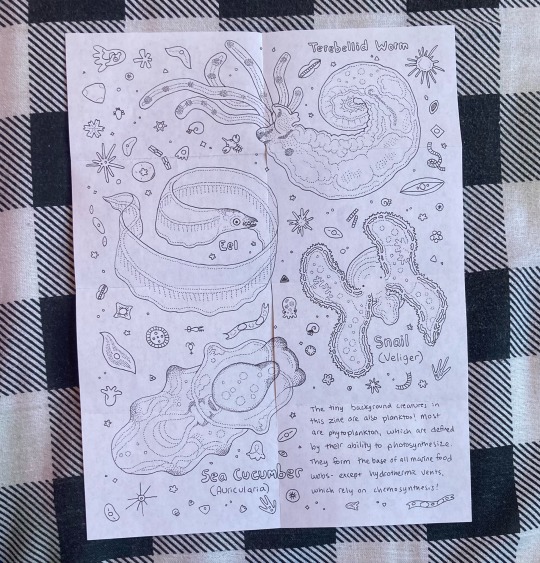
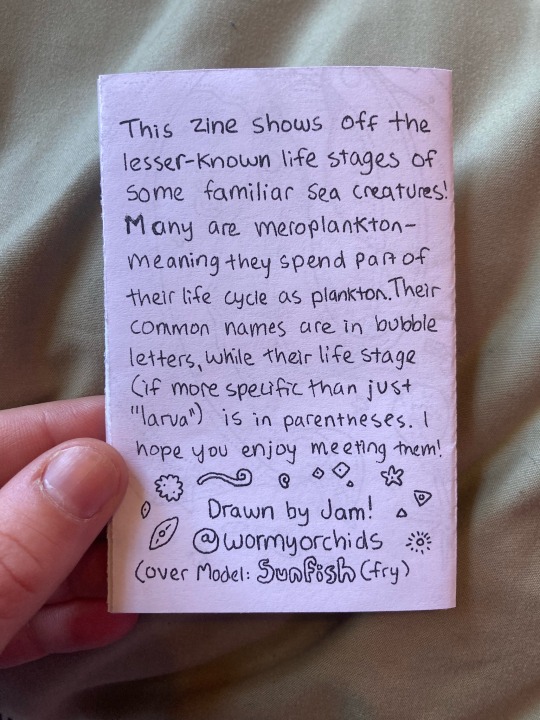

New zine landed! SEA BABIES explores cute sea creature life stages 🦀🪼🐡 snag it in my sh0p or sign up for my mailing list before the end of the month!!
#illustration#drawing#art#creature#stippling#natural history#minizine#zine#marine biology#plankton#larva#life cycles#jellyfish#sea jellies#crab#meroplankton#zooplankton#barnacles#mola mola
56 notes
·
View notes
Text
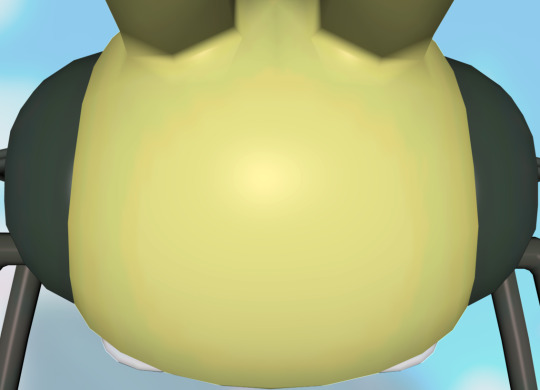
#vibrava#i know the eyes are fucked up i have no idea why. i didn't think it would be so noticeable but apparently it is. so. here's. that#i zoomed it out just a bit so that you could see the rest of it to make it clear it's vibrava because quite honestly i wouldn't be able to#tell that this was vibrava if i didn't. y'know. make this post. i sent it to someone else and they said they wouldn't be able to tell either#i think vibrava into flygon makes sense. i dunno if trapinch into vibrava makes much sense. i used to think that vibrava was the first evo#in the line and flygon was a second evo. but i found out trapinch comes first‚ which looks like an entirely unrelated pokémon to me#i dunno if it's just me. i've talked about not understanding evolutionary lines in the tags before and folks have commented on it telling me#Why They Make Sense Actually and i was just like Damn Ok. it's like interesting to know but shit am i just looking at it wrong#i tend to look for common color schemes and design aspects i guess is my problem. but vibrava looks nothing like trapinch#i dunno what these are supposed to be exactly so maybe it makes sense somehow. like a larva bug hatching from a crab. thing. i dunno#trapinch doesn't look like a bug and vibrava does. i don't. i don't know. why does it get wings. and stay a ground-type
44 notes
·
View notes
Text
Fencing weapon of choice: zoea larva (Porcellanidae)


#i call it the crab stab#or maybe the crabby stabby#you cannot deny i'm onto something here#porcellanidae more like pierce-llanidae#or sth like that#marine biology shitpost#zoea larvae
31 notes
·
View notes
Text
We need shrimp in hallownest
#i keep seing videos of shrimp on my instagram feed i can imagine a whole underwater section#past the drains and their just shrimps and crabs and larva living in their !!!!!!#dustbunnies.txt
5 notes
·
View notes
Text
I’m crying I saved this image of crab larvae to my laptop for work reasons

And this is what the image was already named. I did not name it this

17K notes
·
View notes
Text
Simple lifeform facts I take for granted that I've now seen blowing people's minds on here:
That sea urchins walk around and have mouths with teeth on their undersides
That corals are related to jellyfish
Barnacles being related to crabs and shrimp
Ants being an offshoot of wasps
Termites being totally unrelated to ants and all similarities just being convergent evolution (they're actually a group of cockroaches, but even science didn't know that part until a few years ago)
Starfish having an eye at the end of each arm
That the bodies of ticks and mites are also their heads, essentially big heads with legs (they even frequently have eyes way up on "the body")
Sperm whales have no upper teeth, and also their bodies are flat from the front
Goats also having no upper (front) teeth
Tapeworms having no mouth at all and just absorbing nutrients over their entire body surface
That flies are bigger pollinators than bees
That moths are bigger pollinators than bees
That wasps are just as important pollinators as bees (more important to many groups of plants) and when we say they're "less efficient" at it we just mean individually they get a little less pollen stuck to them.
That honeybees are nonnative to most of the world and not good for the local ecosystem, just good for human agriculture
That earthworms are also nonnative and destructive to more habitats than the reverse
There being no hard biological line between slugs and snails; all slugs aren't necessarily related to each other and there are gastropod groups where some have shells and some don't
That ALL octopuses (not just the blue ring) have a venomous bite
Most jellyfish and sea anemones being predators that eat fish
"Krill" being shrimp up to a few inches long and not some kind of microbe
Blue whales therefore being the deadliest predators to ever evolve as they eat up to several million individual animals per day
That krill are still "plankton" because plankton refers to whatever animals, algae and other organisms are carried around by the sea's currents, not to any particular group of life or a size category
Fungi being no more related to plants than we are, and in fact more like a sibling to the animal kingdom if anything
Venus fly traps being native to only one small area of North America in all the world
Parasites being essential to all ecosystems
Leeches not having a circular ring of teeth anywhere
That algae is not a type of plant
That most seaweed is just very big algae
That enough wood ends up in the ocean that plenty of sea life evolved to eat only wood
Speaking of which the fact that the "ship worms" that make tunnels in wood are just long noodly clams
Butterflies technically just being a small weird group of moths we gave a different name to
That insects only get wings once they reach maximum size and therefore there can never be a younger smaller bee or fly that's not a larva
Spiders not being any more likely to kill their own mates/young than just a cat or dog might, for most species maybe a lot less often?
6K notes
·
View notes
Text



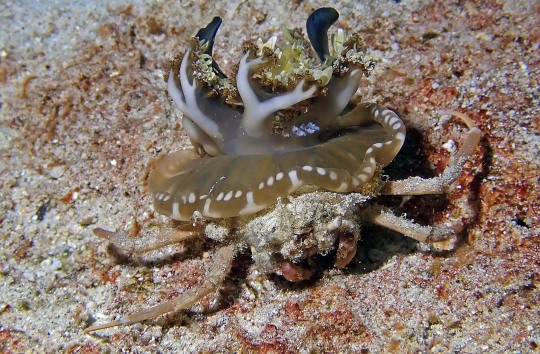

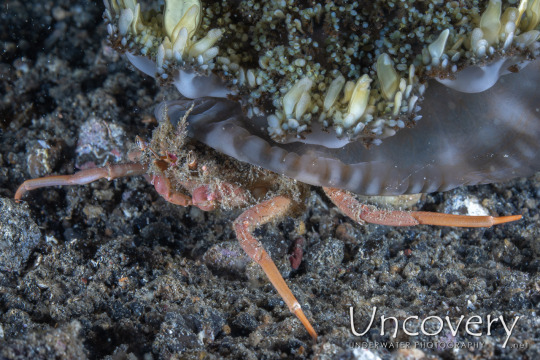

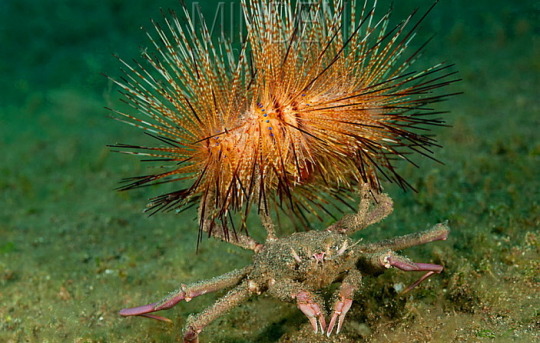

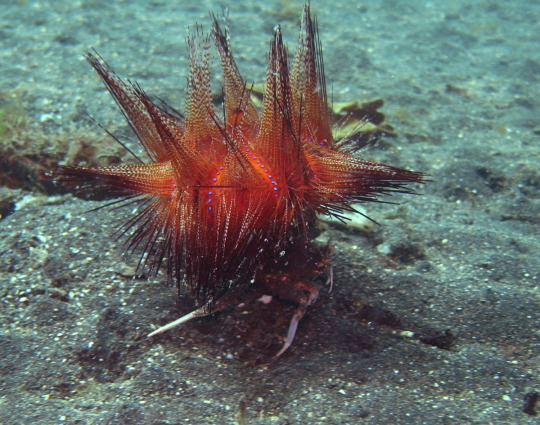

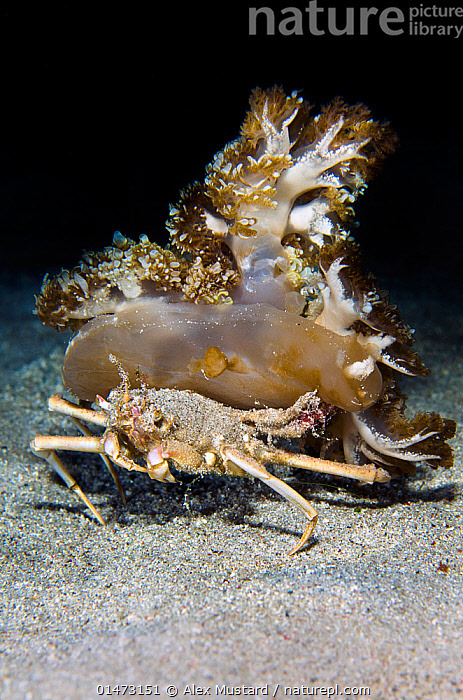
Владелец живой защиты - Краб Дориппе.
Крабы Дориппе считаются относительно древними («примитивными») крабами и относятся к семейству Dromidae. Краб Дориппе чаще всего встречается в Карибском бассейне и прилегающих районах Тихого океана , в частности - возле Панамского канала . Обитает на глубинах от 1 до 15 м, обычно на илистом или илисто–песчаном грунте. Питается различными беспозвоночными, полуразложившимися остатками растений, рыб и других животных.
Размер тела краба Дориппе до 5 см. Первые две пары ходильных ног хорошо развиты и используются для передвижения.Задние ножки Дориппе с эволюцией истончились и скрючились, специально для того, чтобы быстро закидывать на спину все что попадется. За эту привычку его прозвали старьевщиком. Чего только не увидишь на нем – крабы таскают на себе медузу Кассиопею ( и очень часто на этой медузе ,, катаются ,, - потомство этих крабов , - на очень поздней стадии личинки (мегалопа). Также встречаются Дориппе с морскими ежами на панцире. Бывает , что эти крабы защищают себя ракушками моллюсков , которые они используют в качестве щитов. В минуту опасности, краб дориппе подставляет врагу свою спину, чтобы недруг отвлекся на пустышку и дал время быстро покинуть поле боя.
The owner of the living defense is Crab Dorippe.
Dorippe crabs are considered to be relatively ancient (“primitive”) crabs and belong to the family Dromidae. The Dorippe crab is most commonly found in the Caribbean and surrounding areas of the Pacific Ocean, particularly near the Panama Canal. It lives at depths from 1 to 15 m, usually on muddy or muddy-sandy soil. It feeds on various invertebrates, half-decomposed remains of plants, fish and other animals.
The body size of the Dorippe crab is up to 5 cm. The first two pairs of walking legs are well developed and are used for movement. The hind legs of Dorippe have become thinner and curled up with evolution, specifically in order to quickly throw anything that comes across onto its back. For this habit he was nicknamed the ragpicker. You won’t see anything on it - crabs carry the jellyfish Cassiopeia (and very often ride on this jellyfish - the offspring of these crabs - at a very late stage of the larvae (megalope). You can also see Dorippe with sea urchins on its shell. It happens that these crabs protect themselves with mollusk shells, which they use as shields. In a moment of danger, the dorippe crab exposes its back to the enemy so that the enemy is distracted by the dummy and gives time to quickly leave the battlefield.
Источник:https://t.me/+E4YBiErj0A8wOGUy,//ssl.c.photoshelter.com/img-get/I0000WfCNLuEEk1s/s/1200/I0000WfCNLuEEk1s.jpg, /www.alamy.com/stock-photo/dorippe.html?sortBy=relevant, /www.chaloklum-diving.com/marine-life-guide-koh-phangan/crustaceans-phyllum-arthropoda/prawns-shrimps-crustacea/crabs-crustacea/urchin-crab-dorippe-frascone/, /uncovery.net/image-detail/?unc_gallery_id=13714, http://www.fegi.ru/primorye/sea/rak_10_6.htm, /aquastatus.ru/viewtopic.php?t=37858.
#video#animal video#marine life#marine biology#nature#aquatic animals#crab#Dorippe#Urchin Crab#sea urchin#jellyfish#starfish#sand#underwater#ocean view#ocean#animal photography#nature aesthetic#видео#фауна#природнаякрасота#природа#океан#ракообразные#краб#Дориппе#морской еж#морская звезда#медуза#песок
122 notes
·
View notes
Text
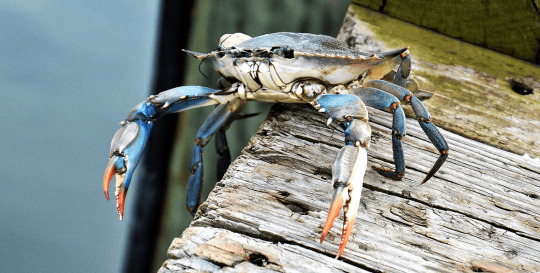


At Last, the Atlantic Blue Crab!
A common sight on dinner tables in Canada, America, and Mexico, the blue crab-- also known as the Atlantic blue crab or the Maryland Blue crab (Callinectes sapidus)-- is native to the the Gulf of Mexico and the Atlantic coast of North America. This species is a bottom dweller, and can occupy a range of habitats from freshwater tributaries to the open bays and gulfs of the ocean itself. At times it may be found at high tide, but most individuals remain submerged at depths up to 36 m (120 ft) deep.
As indicated by its name, the claws and front body of male blue crabs are bright blue. Females are carry a blue tinge, but are largely brown or olive, though the tips of their claws are bright red. Otherwise, the two sexes may be distinguished by the shape of their underside, or "apron"; males have an inverted 'T' shape, while females have a wider, rounder shape. Individuals of both sexes may grow up to 23 cm (9 in) in width, and weigh up to 136 g (0.3 lbs).
Spawning for C. sapidus can occur year-round, but for most populations it peaks in October or November. When females are ready, they travel up estuaries and rivers to where populations of males are more concentrated, and then release pheromones in their urine to attract mates. Male crabs then compete for access, and guard their chosen mates fiercely for up to a week. During this time, the female molts, at which point the male fertilizes her. Afterwards, she may retain her mate's sperm for up to a year, during which time she returns to saltier waters. A female can fertilize 2 million eggs at a time, and will carry them in a mass under her abdomen until they hatch, about a week after fertilization. She may do this as many as 4 times throughout a single mating season.
Once hatched, Atlantic blue crab larvae are released into the ocean. Each larvae spends 30-40 days going through seven larval stages known as zoea; these stages are similar to the instars of a larval insect. However, zoea have hard shells and must molt at each stage of development. After the initial zoea stages, juvenile C. sapidus enter the megalops stage, which lasts 6-20 days. During this time juveniles move from the ocean into the estuaries in which they spawned. Finally, they molt into their final form, which resembles an adult-- albeit much smaller. Both males and females continue to molt throughout the year until they reach their full size. In total, both sexes go through about 25 molts each throughout their lives, which spans about 3 years in the wild.
Blue crabs have a wide and varied diet, as they are omnivores. In their larval stages, Maryland blue crabs consume primarily plankton and detritus. Megalops and adults will feed on clams, mussels, and oysters, small fish, kelp, seaweed, carrion, smaller blue crabs, and animal waste. In turn, both juveniles and adults are food for eels, large fish some sharks, stingrays, and humans. In fact, predation upon larval and sub-adult blue crabs is so heavy that, of 8 million eggs released by the mother, only 1 or 2 typically survive to adulthood.
Conservation status: The Maryland blue crab has not been evaluated by the IUCN. However, in recent decades, fisheries have noticed a severe decline in abundance, likely due to over-harvesting and pollution.
If you send me proof that you’ve made a donation to UNRWA or another fund benefiting Palestinians– including esim donations and verified gofundmes– I’ll make art of any animal of your choosing.
Photos
Kim Cover
Lynn Strauss
Jo O'Keefe
#atlantic blue crab#Decapoda#Portunidae#swimming crabs#crabs#decapods#crustaceans#arthropods#marine fauna#marine arthropods#coasts#coastal arthropods#atlantic ocean
92 notes
·
View notes
Text
in the far-flung future, gene editing will be considered an art form, like sculpture or music
skyscrapers are not built, but grown from redwood saplings. crab-like grubs run people and goods from place to place on specially grown rails, not trains. chittering birds fill cities with the sounds of classical music, jazz, and whatever's on the radio. computers forged from human brain tissue run billions of equations per second, solving hundreds of eternally vexing problems in mathematics, physics, and astronomy.
when you walk down the street, you see people with orange-plumaged wings, cat ears and tails, bioluminescent spots, tentacles, extra arms, decorative horns and antlers and antennae. gender is dead, the idea of assigned sex even moreso. some abscond from civilization altogether, roaming forests where their ancestors may have killed off the wildlife. a dragon-headed waiter flambes a couple with matching moth wings' desert with his own fiery breath.
data can be stored in insect larvae, or beehives. people may ride to work on giant salamanders or horses with eight legs. it is peaceful
mankind is exploring the stars with spaceships crafted from nautiluses. Mars and Venus are lush with life created for their own biospheres. grade-schoolers learn this art by giving frogs wings, or many eyes. look out at the managerie tilling the fields, herding the sheep. they were all once human, but are now something beyond that.
someone's learned to run DOOM on a cuttlefish
260 notes
·
View notes
Text




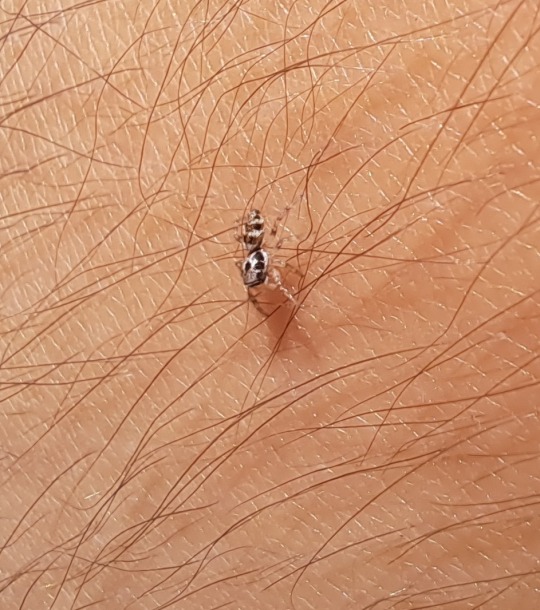





@moth-queer submitted: Some pnw friends :)
You didn't ask for IDs so I assume I'm just meant to admire. I love them all but especially the green moth that looks like it would blend in perfectly with a nice lichen!
#animals#insects#bugs#spider#arachnids#submission#damselfly#caterpillar#larva#jumping spider#crab spider#moth#myriapods#millipede#long post
117 notes
·
View notes
Text
Actually, fuck it.
Metroid Prime 1 Edibility List.
With actual research and considerations*, going in the order the Metroid wiki lists them! One Caveat, if not mentioned to be toxic in any way then I am assuming non-toxicity, UNLESS a similar creature from Earth is poisonous.
Parasite: their size and large numbers would seem to imply they’d have decent meat on them, though their nature as pests may imply they could carry disease. Overall I’d put them in a similar area with rats: Edible with proper cooking and cleaning, but probably less pleasant than most edible creatures.
Auto Turret: Inedible, made of metal and wires. And unlike some Pirate contraptions I see no tortured animals used to make this one either.
Tallon IV Zoomer: The Zoomer itself is likely edible, but the species apparently carries a flesh eating bacteria that makes safely handling the species for consumption difficult. Indirectly inedible, but if raised without contracting the bacteria (or properly cleaned, IRL flesh eating bacteria can be killed with bleach) almost certainly similar to crab meat (with more legs than a crab as a bonus!)
Tallon IV Geemer: in terms of meat quantity, you’d think they’re similar to the Zoomer, but the fact that the spikes retract may imply a difference in muscle structure and/or carapace thickness that could mean less meat for consumption. As for actual edibility, implied to have a similar diet to the Zoomer (mentioned as disease carriers, and irl flesh eating bacteria is usually gotten from improper sewage handling), thus same rating as the Zoomer.
Sap Sac: Mentioned as being very sweet and delectable, and are visibly very large and fleshy, so edible… ON ONE CONDITION: Sap Sacs are explosive, but the logbook mention that only “Brave or ingenious creatures eat it” implies there are ways to consume Sap Sack flesh without being exploded. Based on the Remastered logbook image, it's likely you can eat a certain amount of the outer flesh before hitting the explosive core.
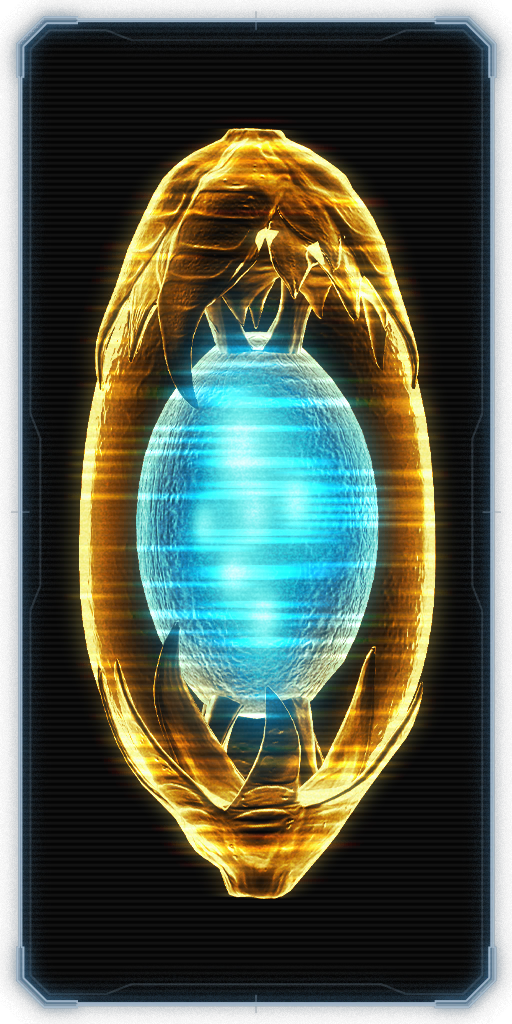
(Sap Sac Image for reference)
Bloodflower: Likely poisonous, at the very least has some manner of organ or gland that creates the projectile toxins that would need to be removed. Petals look unusually fleshy, and the three mouth-nodules could be similar to snakes, but overall edibility seems... unlikely, at best something that would require an intensive process to achieve.
Seedling: These seem to be surprisingly fleshy for plants, and no mention of toxicity or poison is made. Lower body seems similar to a slug or snail, but no slime trail is observes so likely not as similar as visuals may suggest. Combined with plant-based nature, Seedling is possibly edible and fruit or vegetable like, though it is unusually a plant one has to hunt before eating. Spines likely best if removed, but as the spines are not mentioned to be venomous, it's possible they could be a case of "safe to ingest but not desirable"
Tallon IV Scarab: Small-ish explosive bug, likely edible if you could somehow harvest and cook one without it exploding, but this seems so impossible I'm marking it down as inedible.
Beetle: Large arthropod similar to Zoomer/Geemer, but with added benefit of no mention of flesh eating bacteria. Best outcome, similar to crabs but absolutely massive. Worst outcome, tastes terrible like some insects but otherwise not toxic.
Plated Beetle: Like regular Beetle, but even more massive! Exposed abdomen is large, fleshy, and soft, which means it would likely be an excellent protein (assuming it doesn't taste terrible). Meanwhile, insides likely similar to that of non-plated cousins.
Tallon IV War Wasp: The Wasps themselves are likely edible! Bees and similar bugs on earth are actually a delicacy in some regions, especially the larvae, so War Wasps are possibly similar. Adult bees and wasps can be ground up to make a sort of flour, so there's a potential edibility point. Meanwhile, a logbook entry from Hunters indicates the Luminoth harvest War Wasp hives for the royal jelly, and it's possible that War Wasps have honey, like some terrestrial wasps (though as the vast majority of wasp species don't make honey, it is a slim chance.) Overall, War Wasps are likely incredibly edible.
Ram War Wasp: See the basic War Wasp, though notably in their boss fight, Ram War Wasps have an unusual tendency to dip their stingers into the toxic water seemingly as a means of poisoning them. Likely non-toxic themselves, but it could mean wild Ram War Wasps have contaminants in them.
Barbed War Wasps: Again, see the basic War Wasp. Seemingly a point in the favor of the Barbed War Wasp's favor is their absolutely massive abdomen, however the abdomen is likely larger to house the necessary biological mechanisms that allow for the firing and rapid regrowth of their stinger, as well as the production organs for the acidic compound contained in said stingers, which would almost certainly make Barbed War Wasps require more work to prepare for consumption. Still, likely edible if the proper preparations are taken for the abdomen.
Tallon IV War Wasp Hive: Hive itself likely inedible, but contains War Wasp larvae, royal jelly, and possibly honey (See War Wasp).
Eyon: A giant eye. In some Earth cultures, certain animals' eyes are considered a delicacy, and these are massive. Likely edible if they can be killed and have whatever produces the energy beam removed.
Plazmite: Likely similar to the Earthen Firefly, which is toxic due to all the chemicals needed for the bioluminescense. So, we can safely assume the Plazmite is equally inedible.
Shriekbat: Incredibly high internal temperature (121 Centigrade!) with no harm to self likely means even if they probably aren't poisonous, you'd have to wait forever for it to cool enough to safely eat. If we assume they are kept from cooking themselves while alive through either special organs or an incredibly efficient circulatory system, however, possible the meat of a dead Shriekbat cooks itself from leftover heat. Probably edible but impractical to work with. On the plus side, likely hot enough to kill potential parasites and microbes that try to infest them!
Tallon IV Tangle Weed: Simple plant with no mention of toxicity, likely all individual tendrils of a patch are attached to a singular bulb if their Venom Weed cousins are any indication. Probably edible, though if it is a single bulb one may need a shovel to dig it out.
Tallon IV Venom Weed: Similar to Tangle Weed, but contains a potent, seemingly corrosive venom delivered by barbs, presumably similar to how jellyfish deliver their venom. Further, the toxic water of the Chozo Ruins the Venom Weed is found in is implied to be have made the Venom Weed toxic. Likely inedible barring any changes in the future after the toxic water is gone.
Blastcap: Explicitly mentioned poisonous flesh, spores corrosive enough to eat through Samus's armor (seemingly), and also explodes. So goddamn inedible.
Reaper Vine: Appears to be a long, thick, bramble-like vine, but the ability to move itself implies some kind of muscle analogue. Main vine possibly edible but likely unpleasant, eye might be decently edible. Scythe head likely too tough to eat, sharp and hard enough to damage power armor.
Stone Toad: Large amphibian with rock hard skin and seemingly soft insides. Likely edible like some frogs are on Earth, and being a predator that eats smaller prey whole and with no mention of venoms or toxins likely needs no special preparation. Tough skin could help keep moisture in, keeping flesh nice and juicy for consumption throughout cooking. Only downside is figuring out how to kill and butcher one for consumption with rock hard skin in the way. Theoretically perfectly edible, hindered by lack of means to get through skin to prepare for consumption.
Plated Parasite: See standard Parasite entry at the top. Tougher, nigh unbreakable skin means this one is even more unappealing.
Oculus: Based on official art, somewhat turtle-like creature with a single eye on the top of their shell. Likely edible in the same ways turtles are, though legs are more like crab legs. This all said, the electricity generation means there are likely special organs that require special attention and removal to make the creature's meat edible.
Plated Puffer: Coated in metal and filled with toxic gas. Definitely inedible.
Hive Mecha: Robot, inedible. Contains Ram War Wasps however.
Incinerator Drone: Robot, inedible.
Chozo Ghost: Too intangible to eat, most likely.
Grizby: Large arthropod similar to Zoomer and Geemer, mentioned as carrion feeder, may carry bacteria. Otherwise, likely similar level and state of edibility. Tough carapace would help keep meat together while cooking, similar to cooking some shelled animals in their shell.
Burrower: Large arthropod with acidic spit. Likely too acidic to eat safely, though only the projectile spit is mentioned as acidic. At best need to remove saliva glands, maybe avoid the head all together.
Puffer: See Plated Puffer, just minus the metal coating.
Triclops: Large arthropod similar to Beetles. Likely similarly edible.
Magmoor: Large serpents that live in magma, can breathe fire. Definitely incredibly heat resistant, cooking flesh for consumption is likely difficult unless the skin is capable of surprising levels of temperature insulation, and if they can evolve to live in magma there's potential for parasites and diseases to do the same. Still, nothing suggests the meat is toxic, aside from potentially collecting minerals in their body from living in molten rock. Will put the Magmoor down as a solid "Maybe Edible in certain conditions/with certain prep work"
Puddle Spore: Lava Mollusk. Likely impossible to properly cook as even the insides are not hurt by the extreme heat of lava/magma, meat likely similarly builds up minerals from lava over time as suggested with Magmoor. Probably not edible.
----(Text Block Spacer)----
Crystallite: Large arthropod with ice shell. Ice shell unlikely to impart anything unique to Crystallite flavor wise, but likely as edible as any other large Tallon IV arthropod.
Ice Parasite: Likely similar to standard and Plated Parasites.
Ice Shriekbat: Similar to standard Shriekbat, but icy coating may help cool meat faster. Plus, high internal temperature combined with frigid environment could limit successes of diseases and parasites further than even basic Shriekbat (thermal shock.)
Pulse Bombu: Living ball of electricity, almost certainly inedible.
Scatter Bombu: See Pulse Bombu.
Ice Burrower: Similar to Burrower, but with icy outer shell.
Ice Beetle: Like standard Beetle, but with icy coating.
Flickerbat: Smallish flying hunters that eat small insects. Probably edible, though small, fast, and invisible enough that hunting some may be impractical.
Jelzap: Large aquatic apex predator. Likely edible, though if it's anything like sharks (One of Earth's aquatic apex predators), they may have high concentrations of mercury. Naturally composed of two halves connected by electrical impulses, butchering for meat likely somewhat simplified by this.
Baby Sheegoth: Young Sheegoth, still growing. Highly mobile predators, no mention of being poisonous and no venoms used in hunting implies lack of toxicity. Ice shell likely needs removal, small nubs in back that appear to be the beginning of the adult Sheegoth's crystal cluster likely also inedible. As Sheegoths move (and move fast), they likely have incredibly tough meat in their legs.
Adult Sheegoth: Baby Sheegoth but bigger and older. Crystal nubs in back have become absolutely gargantuan with age. Leg meat likely even tougher than that of Baby Sheegoth. Still likely edible though. Should find use for Sheegoth crystals, very pretty and can absorb energy as a defense mechanism.
Sentry Drone: Inedible, Machine. Unfortunate, as they're annoying enough that I wish I could eat one as a power move... Did I type that out loud?
Space Pirate, Tallon IV Deployment: Likely edible, but ethically I have Questions. Yes these guys are assholes but uh... you'd be eating a sapient creature.
Shadow Pirate: See Space Pirate. Cloaking device probably does not give invisibility when eaten.
Flying Pirate: See Space Pirate. Jetpack fuel likely toxic as well.
Aqua Sac: Like the Sap Sac, but instead of exploding this one just breaks into pieces that float away. Probably even more edible than the Sap Sac!
Tallon Crab: Formerly edible, but sadly Phazon mutation/contamination has made them no longer edible. Thanks Space Pirate High Command. >:(
Aqua Reaper: Looks like a giant squid or octopus tentacle. If they are like giant space octopus tentacles then I'd say edible, Space Calamari.
Aqua Drone: See Sentry Drone, but with added sogginess.
Aqua Pirate: See Space Pirate. Could see if special armor is salvageable and sell for credits, then just get a meal delivered by Space GrubHub.
Mega Turret: Bigger than Auto Turret, but likely just as inedible what with being made of metal and wires.
Glider: Large flying mollusk. Described as curiously magnetic, can be affected by Grapple Beam. Fleshy parts of body consist of eyes and a bunch of blue fleshy nodules going by official art. At best unpleasant to eat unless cooked in shell, at worst full of ferrous metals that could make it toxic.
Elemental Troopers: See Space Pirate, and no I'm not describing flavor profiles for each trooper.
Elite Pirate: See Space Pirate AND see Tallon Crab. It has both ethics questions and Phazon contamination! Inedible on like 50 levels! Ok maybe just two. Still.
Phazon Elite: See Elite Pirate. But also, has so much Phazon it likely gives radiation poisoning just by being within 10 inches of the thing without shielding.
----(Text Block Spacer)----
Metroid: Metroids are likely edible if they can be killed without shattering them. Outer membrane likely similar to jellyfish (which can be eaten), and rest of body also seems edible if cooked properly. Bioenergy absorption effects on edibility unknown, pirates describe the energy as not really taking a form they can scan or interact with.
Hunter Metroid: See Metroid, but larger and with tentacle that may serve as another edible part.
Fission Metroid: Inedible, result of heavy Phazon mutation/contamination.
Lumigek: Lives in the rotting remains of a Leviathan/Phazon Meteor. Likely radioactive enough to poison through proximity. Inedible.
Parasite Queen: Phazon contamination/mutation, likely inedible for that alone. Also, acidic saliva production is driven into overdrive by mutation, would require removal even if not rendered inedible by Phazon.
Flaahgra (and Tentacles): Source of poisons in Chozo Ruins waterways, likely full of the same toxins and would at best require intensive cleaning and cooking process to render even remotely consumable. Plus, likely a major Phazon mutant. Almost certainly inedible.
Thaardus: Sapient chunks of Phazon ore. Inedible and tooth shattering. Oh and radioactive also a consideration.
Omega Pirate: Arguably the second-least edible Pirate, behind only the Phazon Elite and likely tied with the Berserker Lord from 3.
Meta Ridley: As kickass as being known as the person to bring down and eat a Space Dragon would be, ethically I have Questions since Ridley is Sapient (Check the Manga that detail's canon!). Plus, likely so full of cybernetics that butchering is difficult. Yes I know the temptation to eat him in revenge for Samus's parents is there, but overall I must say edible chemically speaking, but ethically bad.
Metroid Prime: Metroid Prime is undoubtedly so full of Phazon that I'm pretty sure getting anywhere near it without the Phazon Suit should be fatal. Giant arthropod shape could imply similar meat to beetles, but in the NA GC Version it's full of assimilated technology and even without that it's probably just not feasible due to, again, massive Phazon levels. Core Essence even worse, basically the Bombu but made of Phazon energy. 100% Inedible.
61 notes
·
View notes
Note
How do you breed bugs? Do they just go at it as soon as they’re capable of reproducing? Are they ever picky? Do you just open their container one day and suddenly find eggs you didn’t expect? I think about this every time breeding is mentioned, I’m curious on how it’s intentionally done.
vastly different for every animal, but I’ll try to condense it here; also I mainly have experience with the taxa I talk about below and don’t really know much about breeding scarab beetles, butterflies, shrimp & crabs etc.
the most basic stuff is things like isopods, some millipedes, and many cockroaches, which are kept in colonies and can breed freely—as you said most do so as soon as they can (I’ve seen pregnant isopods 1/4th of their maximum adult size). many cockroaches and all isopods are live-bearing, though, so there frequently aren’t visible eggs involved!
certain species of the above taxa need special care to trigger breeding or hatching: a cooling/drying/heating/moistening period of eggs or adults to mimic the seasons in nature. many desert or temperate species need this sort of climate control. in some cases these requirements are so strict that the species will not breed in culture—Orthoporus ornatus is a SW US species that has never been reliably bred; Asbolus death feigning beetles from the same area are usually collected as adults and kept on sand but larvae cannot successfully develop without richer organic material and humidity control, so sadly most people do not breed them even though it’s just a little more effort.
for solitary, cannibalistic predators like mantises, spiders, and centipedes that must be kept alone, one is usually introduced to the other under human supervision to make sure they’ll get along. feeding the hungrier sex (often females) may make them less prone to eating their mates; many mantises are best paired while the female is already occupied with food. tarantula egg sacs are often pulled from the mother and incubated artificially; spiders aren’t my thing and I don’t know fully why this is done (easier to catch and monitor health than 60 baby fuzzies down a deep burrow, I guess). scolopendromorph centipedes are dedicated mothers but will eat their own eggs if disturbed, so you’ve got to keep them dark and totally quiet with no food for several months until the kids are mobile.
sexing certain taxa is difficult too—in tarantulas and mantises sexual dimorphism can be extreme, whereas in most centipedes sexes are identical to the human eye and must be anesthetized and manually probed to tell.
some scorpions (all scorps are livebearing too) and some cockroaches, for example, are parthenogenetic, which means females just clone themselves and need no partner, which is a reproductive strategy that lends itself to colony keeping. certain stick insects and mantises can be facultative parthenogens that can pop out viable kids if they haven’t mated, but apparently these aren’t always the healthiest and pairing is best when possible.
120 notes
·
View notes
Text
Atlantic Ghost Crab, [The Cannibal]
[Ocypode Quadrata]
Ready to learn about the Hannibal Lecter of crustacean family? Hop on board!

Starter : The Atlantic ghost crab, Ocypode quadrata, is a species of ghost crab. It is a common species along the Atlantic coast of the United States, where it is the only species of ghost crab.
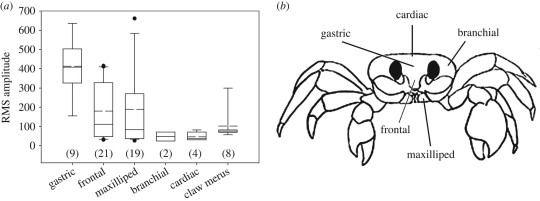
Some fun facts about this good spooky fella!
A 2023 study using the well known mirror test found that these crabs seem to be capable of recognizing themselves in a mirror. They are self-aware.
The atlantic ghost crabs must return to water periodically to moisten their gills, and when larvae must be released into the sea, but they are otherwise terrestrial.
Their stalked compound eyes can swivel to give them 360° vision.

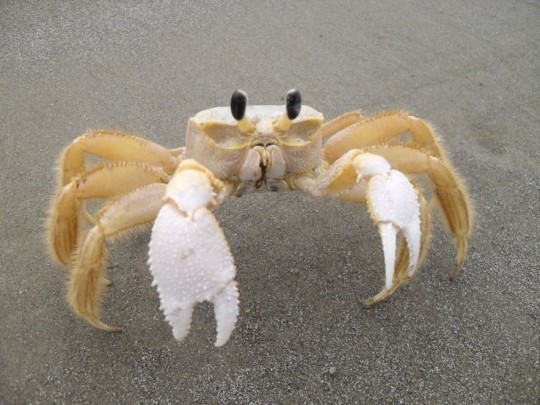

Fun Fact! Ghost crabs are arguably the fastest terrestrial invertebrates, capable of running at more than a meter per second.
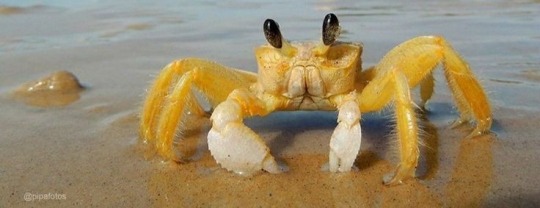
The Atlantic ghost crab lives in burrows (like fiddle crabs!) in sand above the strandline.
These burrows can be up to 1.3 m (4'3) deep, and can be closed off with sand during hot periods.
Young crabs are cryptically colored to blend in with their sandy habitats. This way predators are less likely to see them.
Ghostie mate can produce a variety of sounds by striking the ground with the claw, by stridulation with the legs, and an incompletely explained "bubbling sound"

O. quadrata is more active at night than in the day, and is an omnivore, eating clams, mole crabs, insects, plant material, detritus, and even other crabs. They also feed on the eggs and hatchlings of sea turtles.
CANNIBALISM!? Traitors shall walk the plank!
Ghost crabs are both predators and scavengers, and they feed at night. Their prey can be influenced by the type of beach they live on.
These fuckers arr' also mostly carnivores. They got taste, don't they?


Pic by Eugene Bobylev | [Credits] | [Credits]
#crab#tumblr crabs#crabs#crustacean#decapod#decapoda#crab day#marine biology#fishblr#fiddler crab#sea life#ocean life#biology#adhd brain#hyperfixation#captain kuppa
123 notes
·
View notes
Photo
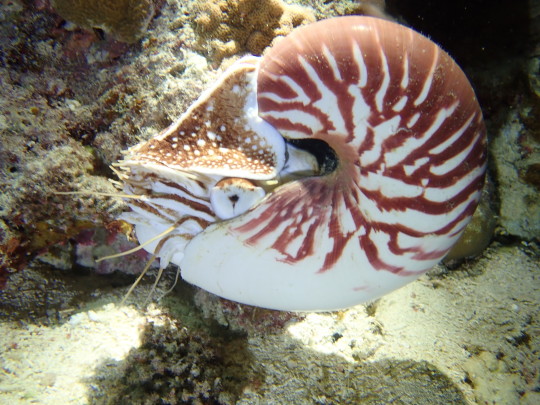
Chambered Nautilus (Nautilus pompilius)
Family: Nautilus Family (Nautilidae)
IUCN Conservation Status: Unassessed
The fossil record shows that hard external shells were common among early cephalopods, but today the six living species of nautilus are the last cephalopods to retain the external shells of their ancestors, limiting their agility and flexibility but providing them with a highly effective defence against predators (primarily octopuses and large fish) and granting them a high degree of control over their buoyancy: within the shell of a nautilus there are several chambers with a tube-like structure across which gas and water can be transferred, known as a siphuncle, running between them - by filling a chamber with gas the nautilus can increase its buoyancy, by filling a chamber with water it can decrease its buoyancy, and by balancing the number of gas-filled chambers and water-filled chambers it can maintain neutral buoyancy. The Chambered Nautilus is the largest living nautilus (with exceptionally large individuals having a shell diameter of up to 25cm/10 inches, although smaller sizes are more typical), and can be found in the Indian and western Pacific oceans where it typically inhabits shallow coastal waters and coral reefs. It swims by forcing water out of a flexible tube-like structure near its head called a siphon (which can be aimed to alter its direction of movement), and feeds largely on carrion and detritus which it locates using a pair of chemical-sensitive structures that protrude from above its eyes, known as rhinophores. Although they lack true tentacles, Chambered Nautiluses possess as many as 90 small limbs beneath their eyes (called cirri), which lack the strength and adhesive suction cups of the limbs of squids and octopuses but are capable of grasping carrion (as well as the occasional live animal, such as small crabs) and transporting it to the small, parrot-like beak hidden beneath them. When food is abundant Chambered Nautiluses often gorge themselves, storing excess food in a muscular pouch-like organ called a crop where it can be slowly released into the stomach when it is needed. Chambered Nautiluses reproduce by laying eggs (which are typically hidden in cracks in rocks or between lobes of coral, and hatch after about a year into small but fully-developed young instead of the larvae seen in most cephalopods), and while most cephalopods reach maturity, mate and die within just a few years nautiluses are relatively long-lived, reaching maturity at around 5 years old and potentially living for 15-20 years. The interior of a Chambered Nautilus’ shell is lined with a beautiful silvery substance known as nacre or mother-of-pearl which helps to protect the internal organs if the outer shell is damaged, and the demand for nacre (as well as full nautilus shells) for use in decorations and jewellery has led to a high rate of both legal and illegal hunting of this species, resulting in the Chambered Nautilus being classified as a CITES Appendix II species in 2016 (essentially meaning that they are not currently threatened with extinction, but are now legally protected so as to prevent them from being put at risk of extinction in the future.)
--------------------------------------------------------------------------
Image Source: https://www.inaturalist.org/taxa/123467-Nautilus-pompilius
#Chambered Nautilus#Nautilus#naurtiluses#nautiloids#cephalopods#zoology#biology#Teuthology#animal#animals#marine wildlife#marine biology#cephalopod#wildlife
444 notes
·
View notes
Text
Moth of the Week
Red-Belted Clearwing
Synanthedon myopaeformis
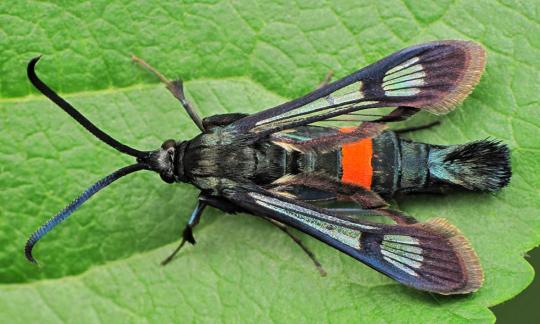
Image Source
The red-belted clearwing is a part of the family Sesiidae. It was first described in 1789 by Moritz Balthasar Borkhausen as Sphinx myopaeformis. This was later changed to Synanthedon myopaeformis. This moth is called the red-belted clearwing in Europe, the apple clearwing moth in North America, and the apple borer. This is due to their tendency to damage their host apple trees. It is considered a pest in Europe.
They may be confused with the large red-belted clearwing and the red-tipped clearwing.
Description This moth has a thin, dark blue, segmented body. The body is hairless aside from a bushy tail at the end of the abdomen. They are noticeable due to a bright red-orange band on one of the segments of the abdomen. The wings are clear with a dark outline and veins and a fringe on the outer margin (outer edge). The wings help distinguish the red-belted clearwing from the large red-belted and red-tipped clearwings as the wings have no red-orange markings.
Wingspan Range: 1.8 - 2.8 cm (≈0.71 - 1.1 in)
Diet and Habitat This species eats mainly apple, specifically Crab Apple (Malus sylvestris), as well as Pear (Pryus communis), Hawthorn (Crateagus monogyna), Almond (Prunus dulcis), Rowan (Sorbus aucuparia), apricots, cherries, mountain ash, peaches, plums, and quince. In Canada, adult moths have been attracted to the flowers of the snowy milkweed.
They can be found natively in Europe, North Africa, and Asia Minor. This species was noticed to North America and first detected in Canada in 2005. They inhabit well established orchards and gardens, hedgerows, open woodland, and mature scrub.
Mating Adults emerge from their cocoons in early summer and on flight from May to August, this is presumably their mating season. Females can lay up to 250 eggs, usually singly in the cracks or damaged areas of the trunk and branches they are hosting in. Females attract males with pheromones released from glands. A 2010 study found that 3,13-octadecadienyl acetate is the primary sex hormone.
Predators The larvae of this moth are preyed on by parasites, fungi, and bacteria. The main parasite of red-belted clearwing larvae is Liotryphan crassiseta. Other parasites are Nematodes, Steinernema sp. The fungi Beauveria bassiana and Metarhizium brunneum are common causes of death in larvae as well as the bacteria Bacillus thuringiensis.
Fun Fact
The adult red-belted clearwings are significantly less active on cold days compared to warm days.
In 2014, Judd and Eby found that S. myopaeformis does not discriminate between yellow, green and white or between purple, blue, red, and black. This suggests that they are dichromatic, meaning they can perceive mainly two colors. This affected traps set to catch this species as they acted differently depending on the light reflected.
As this species is considered a pest to apple trees, people have attempted to control the population. This has been tried with pheromone/mating disruption, pheromone laced traps, other chemical traps, the use of predators/enemies, and the covering of apple tree trunks in oil.
(Source: Wikipedia [1][2][3], Butterfly Conservation, Michigan State University)
#libraryofmoths#animals#bugs#facts#insects#moth#lepidoptera#mothoftheweek#sesiidae#red-belted clearwing#Synanthedon myopaeformis#apple clearwing#apple borer#very late post#sorry for the absence
48 notes
·
View notes
Text

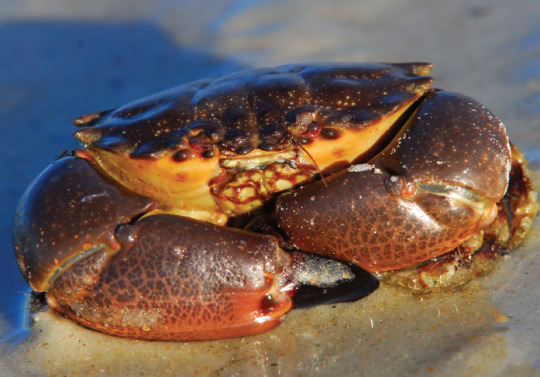
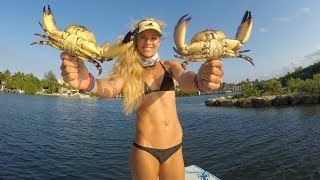

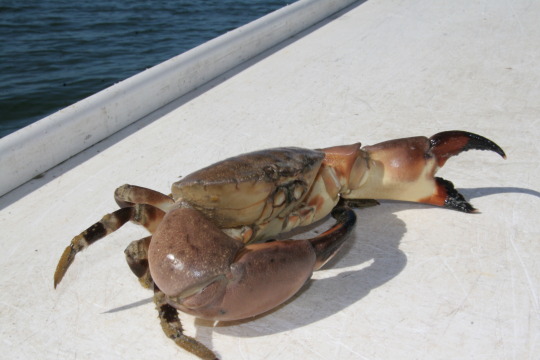

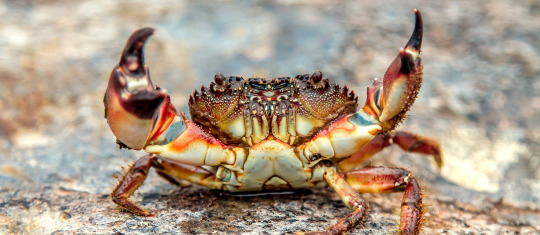
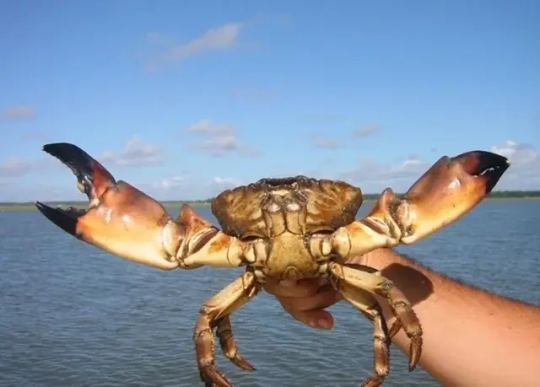
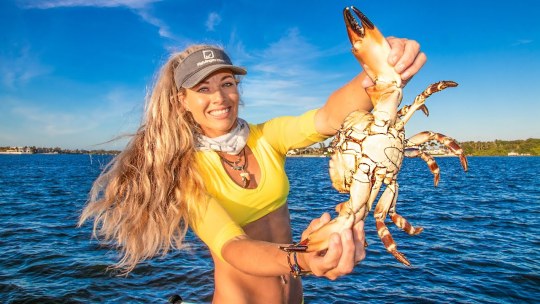


The Florida stone crab (Menippe mercenaria) is a species of true crab native to the coastal waters and salt marshes of the western North Atlantic, from Connecticut to Colombia, including throughout the Caribbean and Gulf of Mexico. Stone crabs typically inhabit shallower waters some 1 to 6.5ft (.3 to 2m) deep often digging and residing in holes on the ocean bottom, oyster reefs, docks, jetties, or rock mounts. Here they tend to spend there days, emerging usually at night to feed up on oysters and other small mollusks, sea grass, carrion, polychaete worms, and other crustaceans. Reaching around 5 to 6.5 inches (125 to 165mm) in carapace length, stone crabs are sexually dimphoric with males growing proportionally larger claws while females tend to reach larger sizes overall. Both sexes are brownish red in coloration with gray spots and a tan underside, sporting large black tipped claws. The Florida stone crab loses its limbs easily to escape from predators or tight spaces, but their limbs will grow back. When a claw is broken such that the diaphragm at the body/claw joint is left intact, the wound will quickly heal itself and very little blood is lost. If, however, the claw is broken in the wrong place, more blood is lost and the crab's chances of survival are much lower. Each time the crab molts, the new claw grows larger. The breeding season of the Florida Stone Crab lasts the whole of spring and summer. The male Florida stone crab must wait for the female to molt her exoskeleton before they can mate. After mating, the male will stay to help protect the female for several hours to several days. The female will spawn four to six times each season, producing up to a million eggs total. The larvae go through six stages in about four weeks before emerging as juvenile crabs, continuing to molt and grow they reach sexual maturity at about 2 years of age. Under ideal conditions a Florida stone crab may live upwards of 8 years.
#pleistocene#pleistocene pride#pliestocene pride#pliestocene#cenozoic#florida#stone crab#crab#florida stone crab#sea life#ocean#crustacean
59 notes
·
View notes